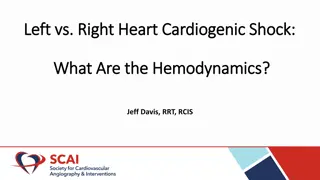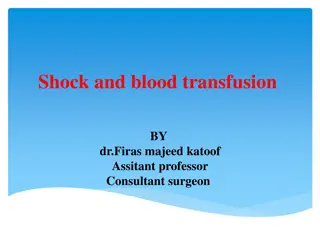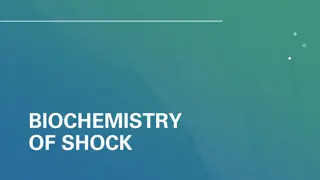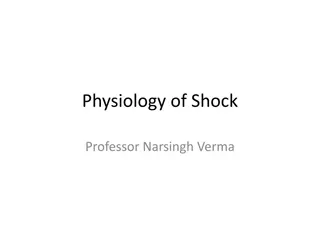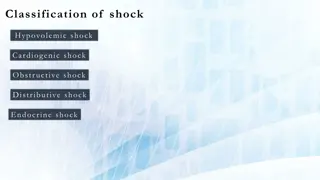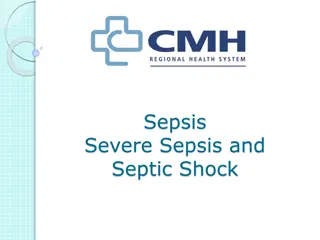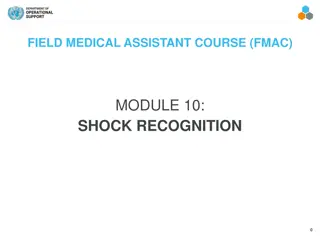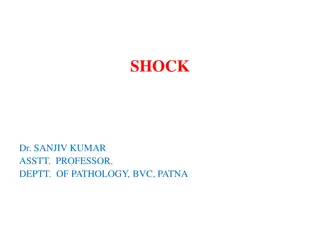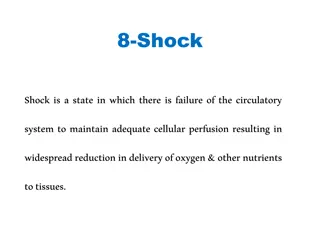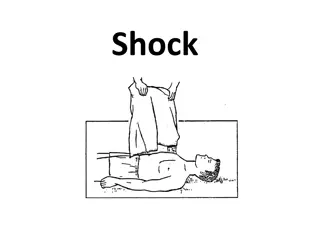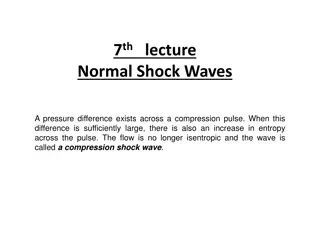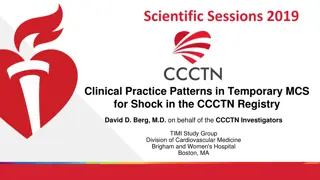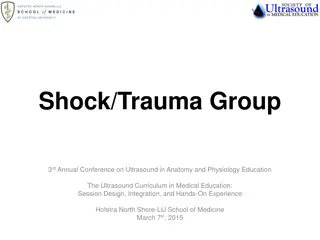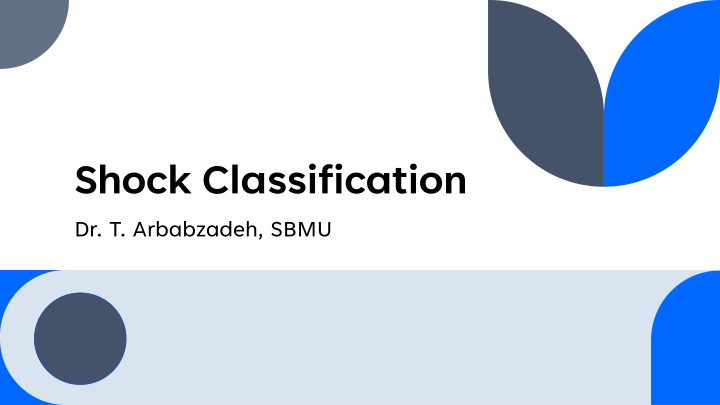
Shock: Classification, Epidemiology, and Types
Explore the classification, epidemiology, and types of shock. Shock is a life-threatening circulatory failure leading to cellular and tissue hypoxia. Learn about distributive shock, cardiogenic shock, hypovolemic shock, obstructive shock, and more. Understand the significance of early identification of septic shock and the National Early Warning Score. Stay informed on the various forms of shock to enhance patient care and management.
Download Presentation

Please find below an Image/Link to download the presentation.
The content on the website is provided AS IS for your information and personal use only. It may not be sold, licensed, or shared on other websites without obtaining consent from the author. If you encounter any issues during the download, it is possible that the publisher has removed the file from their server.
You are allowed to download the files provided on this website for personal or commercial use, subject to the condition that they are used lawfully. All files are the property of their respective owners.
The content on the website is provided AS IS for your information and personal use only. It may not be sold, licensed, or shared on other websites without obtaining consent from the author.
E N D
Presentation Transcript
Shock Classification Dr. T. Arbabzadeh, SBMU
Agenda Introduction Definition Classification Etiology Summary Shock Classification 2
Introduction Shock is a life-threatening condition of circulatory failure Inadequate oxygen delivery Cellular and tissue hypoxia Initially reversible, but rapidly become irreversible Multiorgan failure (MOF) Shock Classification 3
Definition: Cellular and tissue hypoxia due to: Reduced oxygen delivery Increased oxygen consumption Inadequate oxygen utilization Or a combination of these processes.
Epidemiology Septic shock: The most common form of shock among patients admitted to the ICU ( 62%) Cardiogenic shock (16%) Hypovolemic shock (16%) Obstructive shock (4%) Shock Classification 5
Types of Shock: 1 2 3 4 5 Distributive Shock Cardiogenic Shock Hypovolemic Shock Obstructive Shock Multifactorial Shock Shock Classification 6
Distributive Shock Characterized by severe peripheral vasodilatation PRESENTATION TITLE 7
Distributive Shock Septic shock Identification of early sepsis (qSOFA, NEWS) GCS: 15 (0) <15 (1) RR: 22 (1) < 22 (0) SBP: 100 mmHg (1) >100 mmHg (0) qSOFA interpretation: Shock Classification 9
National Early Warning Score (NEWS) score Input Results Shock Classification 10
The usual scoring systems have excluded pregnant women because pregnancy physiology is different and normal pregnancy parameters overlap with criteria for sepsis Bauer ME, Bauer ST, Rajala B, MacEachern MP, Polley LS, Childers D, Aronoff DM. Maternal physiologic parameters in relationship to systemic inflammatory response syndrome criteria: a systematic review and meta-analysis. Obstet Gynecol. 2014 Sep;124(3):535-541. doi: 10.1097/AOG.0000000000000423. PMID: 25162253. PRESENTATION TITLE 11
Two-Step Approach to Septic Shock Screening Step 1: Initial Screen Step 2: Confirmation 12
Sepsis Screening Points 3 1 2 White blood cell values peak 24 hours after administration of corticosteroids for fetal lung maturity(two standard deviations from the mean is 20.8 x 10/L), and return close to baseline values by 96 hours after administration. In the setting of suspected infection, a MAP < 65 mm Hg is sufficient to initiate the sepsis protocol even if other sepsis screening criteria are not met. If an abnormal value is detected, verification of the abnormal value and a complete set of vital signs including oxygen saturation should be taken and repeated after 15 minutes. PRESENTATION TITLE 13
Systemic inflammatory response syndrome (SIRS) A clinical syndrome that is characterized by a robust inflammatory response. It usually induced by a major body insult that can be infectious or noninfectious. PRESENTATION TITLE 15
Neurogenic Shock Evaluation of increased ICP should begin in the ED Clinical signs of impending or ongoing cerebral herniation: Significant pupillary asymmetry, unilateral or bilateral fixed and dilated pupils, decorticate or decerebrate posturing, respiratory depression, and the "Cushing triad" of hypertension, bradycardia, and irregular respiration. Prevention and treatment of hypotension and hypoxia, two systemic insults known to be major causes of secondary injury after TBI Hypoxia (PaO2 <60 mmHg) and hypotension (SBP] <90 mmHg) Interruption of autonomic pathways, causing decreased vascular resistance and altered vagal tone were present in 50 and 30 percent PRESENTATION TITLE 16
Neurogenic : due to spinal cord injury and loss of sympathetic nervous system outflow o Results in venous pooling, peripheral vasodilation o Often has relative bradycardia o Treat with IV fluids first, then alpha vasoconstrictors if hypovolemic shock ruled out Spinal shock : actually is a "cord-stunning" syndrome o Flaccidity and loss of reflexes o Is an "electrical" phenomenon of the spinal cord o May have complete recovery 17
Anaphylactic Shock Anaphylaxis Acute systemic reactions caused by direct release of mediators from mast cells and basophils produced by various triggers. Causes of anaphylaxis Allergens (IgE-dependent) Immunologic triggers (IgE- independent) Idiopathic Nonimmunologic triggers (direct activation of mast cells and basophils) PRESENTATION TITLE 18
Drug and toxin-induced shock Associated with shock or SIRS-like syndromes Drug overdoses (eg, long-acting narcotics) Bites Transfusion reactions Heavy-metal poisoning including arsenic, iron, and thallium Infections associated with toxic shock syndrome (eg, Streptococcus and Escherichia spp). Cyanide and carbon monoxide 1. 2. 3. 4. 5. 6. PRESENTATION TITLE 20
Endocrine shock Addisonian crisis Myxedema Thyrotoxicosis 21
Cardiogenic Shock Due to intracardiac causes of cardiac pump failure that result in reduced cardiac output
Arrhythmic When CO is severely compromised by significant rhythm disturbances (eg, sustained ventricular tachycardia, complete heart block), patients can present with cardiogenic shock. If CO is absent because of the underlying rhythm (eg, pulseless ventricular tachycardia, ventricular fibrillation), patients present in cardiac arrest. PRESENTATION TITLE 24
Mechanical Critical aortic stenosis or mitral stenosis rarely present with cardiogenic shock, but often contribute to hypotension and shock from other causes (eg, sepsis, hypovolemia). PRESENTATION TITLE 25
Hypovolemic Shock Due to reduced intravascular volume: reduced preload reduces CO.
Obstructive Shock Due to extracardiac causes of cardiac pump failure and often associated with poor right ventricular output.
Pulmonary vascular The RV is unable to generate enough pressure to overcome the high pulmonary vascular resistance associated with PE or PH. While hemodynamic collapse in the setting of PE is traditionally attributed to mechanical obstruction, pulmonary vasoconstriction mediated by vasoactive mediators such as serotonin and thromboxane also contribute to the observed pathophysiology PRESENTATION TITLE 30
Stages of Shock Shock is a physiologic continuum 1. Pre-shock: compensated shock, or cryptic shock 2. Shock 3. End-organ dysfunction
Pre-shock A compensatory tachycardia and peripheral vasoconstriction Asymptomatic Preserve a normal or mildly elevated blood pressure despite a 10 percent reduction in total effective arterial blood volume. Tachycardia Mild to moderate hyperlactatemia, may be the only clinical signs of early shock With timely and appropriate management, deterioration can be prevented and signs of impending deterioration can be reversed PRESENTATION TITLE 33
Shock The compensatory mechanisms become overwhelmed Signs and symptoms of organ dysfunction appear: symptomatic tachycardia, dyspnea, restlessness, diaphoresis, metabolic acidosis, hypotension, oliguria, and cool, clammy skin. PRESENTATION TITLE 34
Summary Definition Shock is defined as a state of cellular and tissue hypoxia due to reduced oxygen delivery, increased oxygen consumption, inadequate oxygen utilization, or a combination of the three. "Undifferentiated shock" refers to the situation where shock is recognized but the cause is unclear. Classification Four types of shock are recognized. However, many patients have a combination of more than one of the forms of shock 1. Distributive shock :septic shock, SIRS, neurogenic shock, anaphylactic shock, toxin-related shock, and endocrine shock (eg, addisonian crisis). 2. Cardiogenic shock: cardiomyopathic (eg, myocardial infarction), or due to an arrhythmia (eg, sustained ventricular tachycardia) or a mechanical abnormality (eg, acute valvular rupture). 3. Hypovolemic shock : hemorrhagic (eg, trauma) or nonhemorrhagic fluid losses (eg, diarrhea). 4. Obstructive shock may be pulmonary vascular related (eg, pulmonary embolism) or due to a mechanical cause of reduced 35 preload (eg, tension pneumothorax, pericardial tamponade).


